On the Inca Trail
This is my last weekend in Cuzco. School is finished. Now I can speak a little more Spanish. Will I need it after I already survived during the last two weeks? Maybe I should have learned Quechua, the language of the Inca and still being spoken by the indigenous people, since I will be going to visit one of their best preserved towns and maybe last hiding place: Machupicchu. More about history later on.
First of all, in order to get there I had to buy a railway ticket. But tickets were not easy to get, especially on short notice. Only some travel agencies have already bought up tickets in advance and offered them as part of a package.
One offer was a good deal. I didn't remember the price but it wasn't much more expensive than I would have compiled my own itinerary. And in addition, it included a two days guided trek on the Inca trail plus one overnight stay including meals. I couldn't afford the four days, because my flight back to Lima was due on Monday.
Saturday morning meeting at the travel agency. I was not the only traveler, of course. Three girls and a guy were already waiting for me. The guide introduced himself and we did get a lift to the railway station.
All the seats were reserved and the train ride was smooth until we reached km104. This was not an official station but the train stopped to let the passengers off who want to start here on the Inca trail.
Click the small picture to get it enlarged
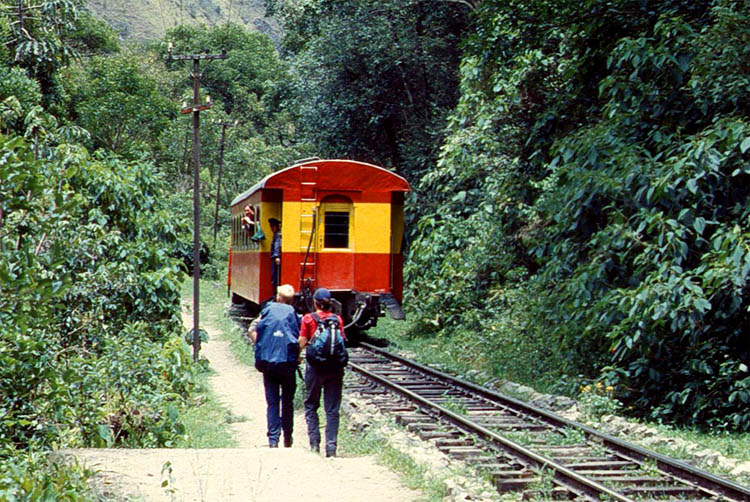
| There goes our train after we did get off
|
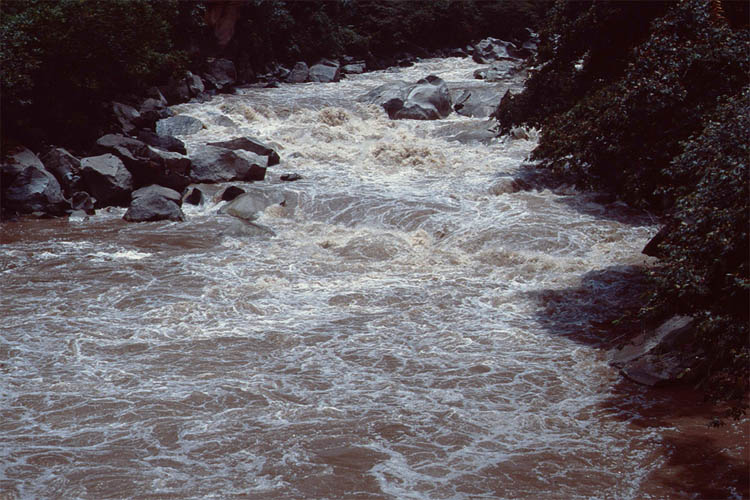
| Then we had the wild Urubamba to cross
|
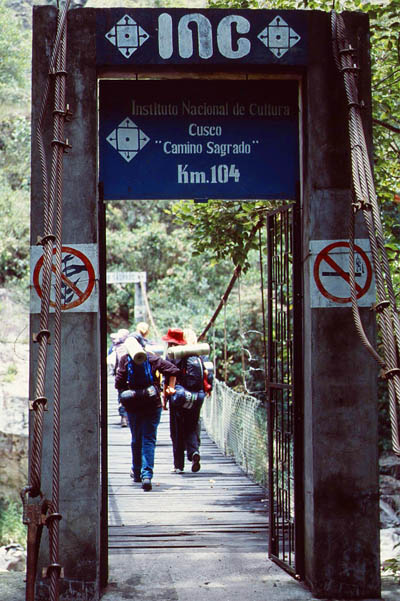
| There was a nice hanging bridge to get to the other side
|
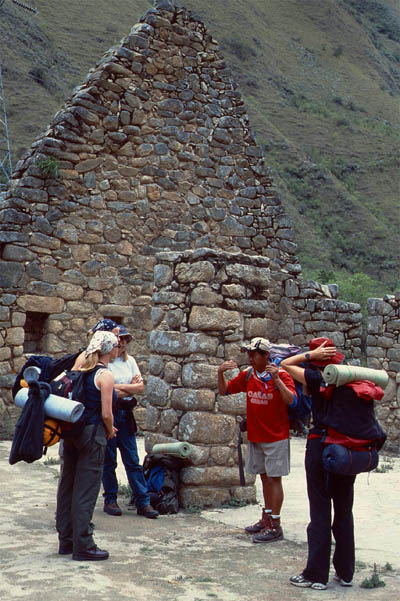
| Where we did get the first instructions from our guide
|
After we paid our entrance fee (12 USD) at the old Inca ruins of Chachabamba we continued walking a little bit up the hill and then along the original Inca trail cut out from the hill while looking down into the Urubamba valley. It was not strenuous at all and I could do it again when I am 84. Also the altitude of 2240m was much lower than in Cuzco.
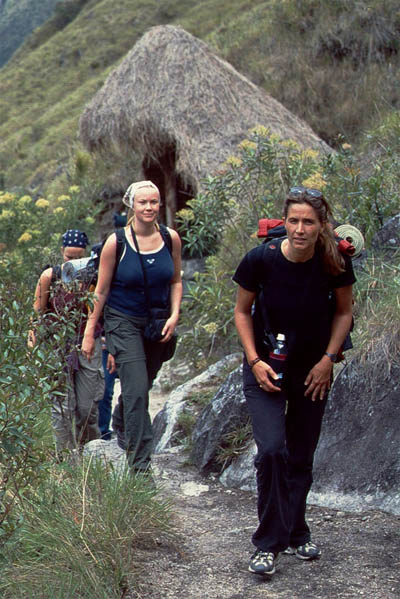
| I had to lead up the girls
|
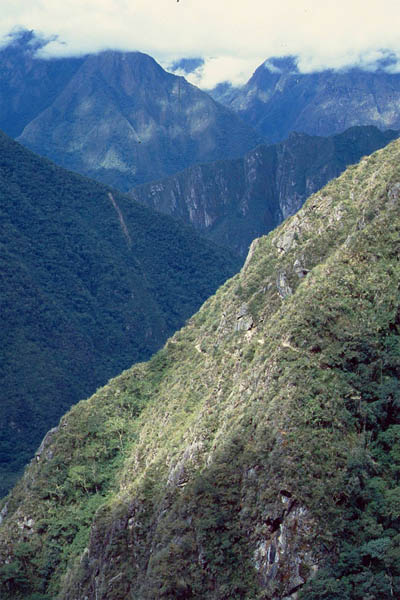
| Walking on one of the small Inca trails
|
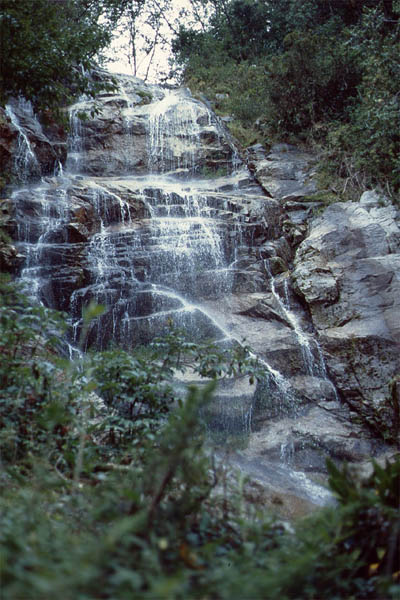
| Passing unspoiled nature
|
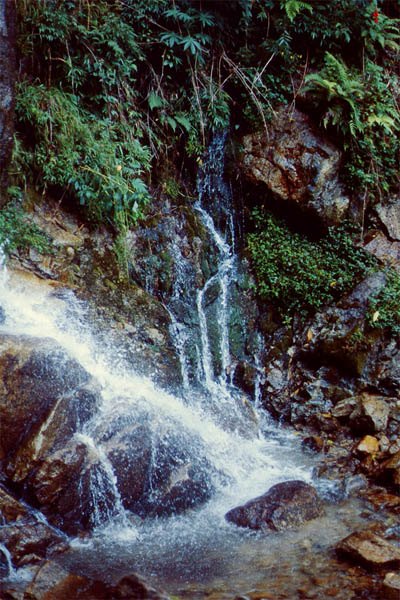
| with some waterfalls
|
Wiñaywayna
As we came around the hill a bit, what did we hit? The most impressive terraces I ever saw with a village in the middle all made of stones. After we did get up the trail we saw no one living there. Where have all the people gone? At least the name of this place they must have left behind, which is Wiñaywayna. And this is not the only abandoned terraced village around here, not to mention Machupicchu.
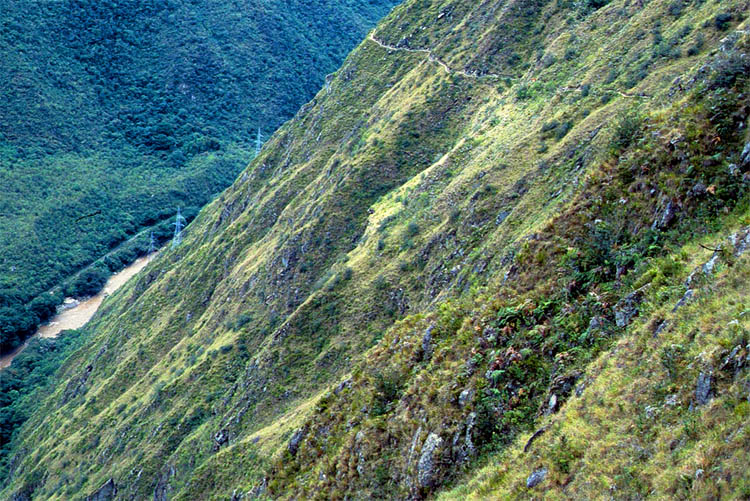
| Looking back and down, what a sight
|
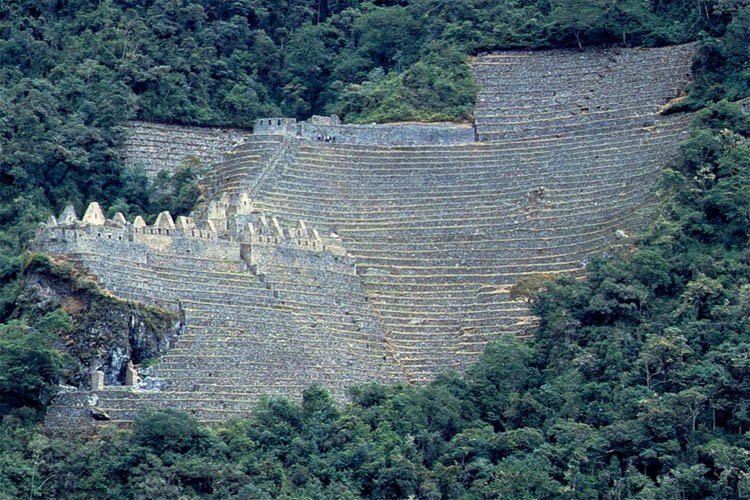
| looking forward and up: what a sight
|
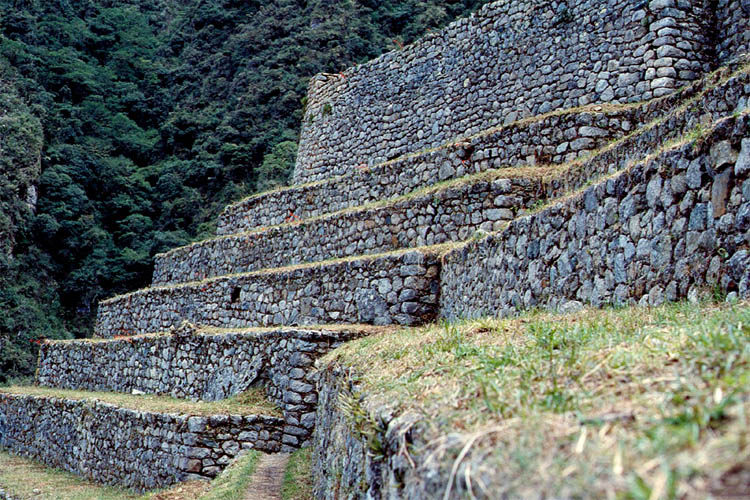
| Going up the terraces
|
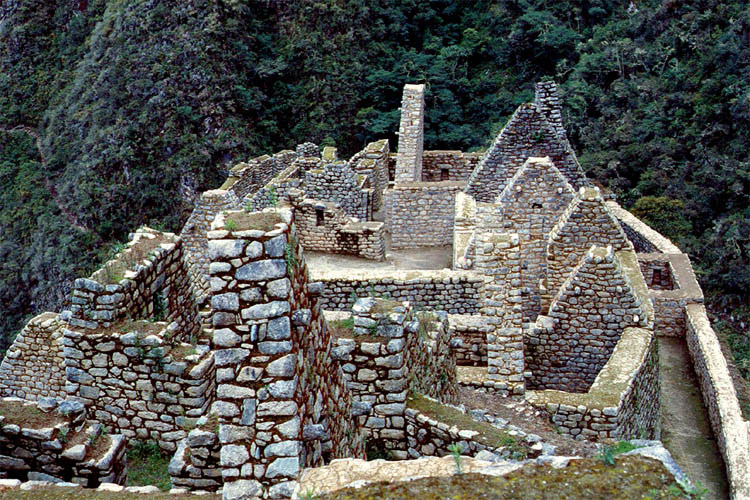
| Looking down at the houses
|
How can this be all so neat and clean and well preserved if nobody seemed to do any maintenance. Ok, it didnīt look that way when it was detected in 1942. It took a couple of years to free it from overgrown jungle. Now it looks like if the people can settle down again by just putting roofs on the stone houses and start planting crops on those terraces right away.
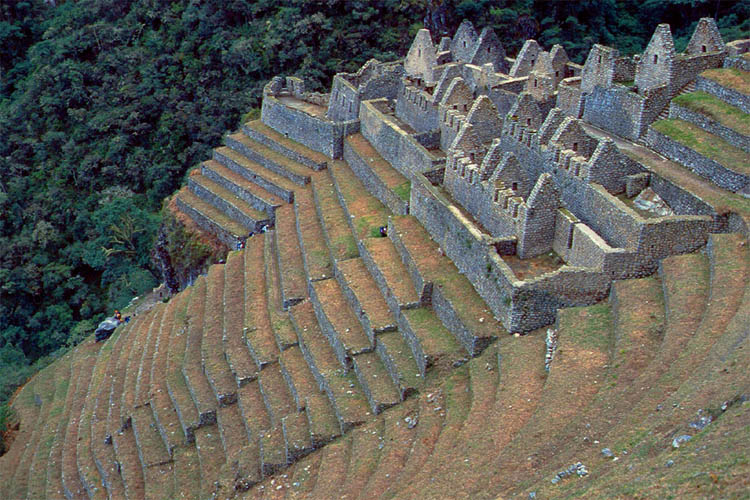
| The Eighth World Wonder?
|
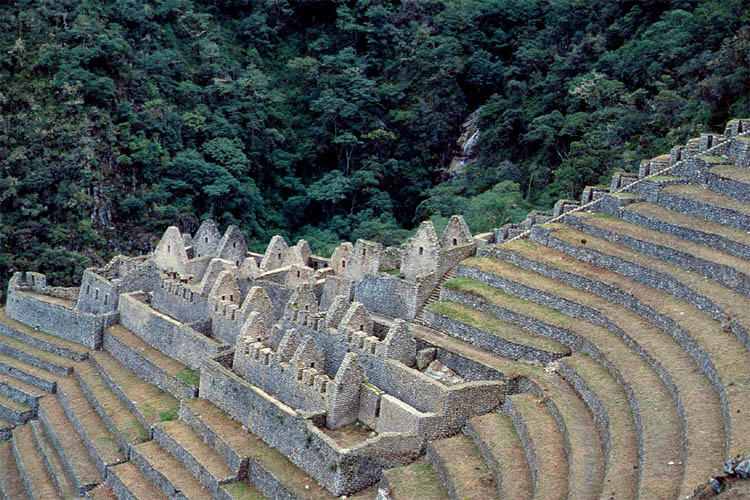
| And this is not even Maccupicchu yet
|
Centro de Vacaciones
After passing Wiñaywayna we continued on the Inca trail until we reached the Centro de Vacaciones, our place to stay overnight. And here we were not the only ones. A whole bunch of travelers, who did the 4 days Inca trail hike, invaded this place from another direction.
We were hungry but had to wait until our guide has prepared our dinner. A whole bunch of guides competed to use one of the many "kitchens", only a little separated by canvas. We travelers could eat in the "restaurant", but it was not easy to find a seat.
Where to sleep? I had already reserved a bed in the dormitory as part of my package. The others of our group chose to sleep in tents, which was cheaper but colder. Though, it was not that warm in the room either, so I slept with my clothes on.
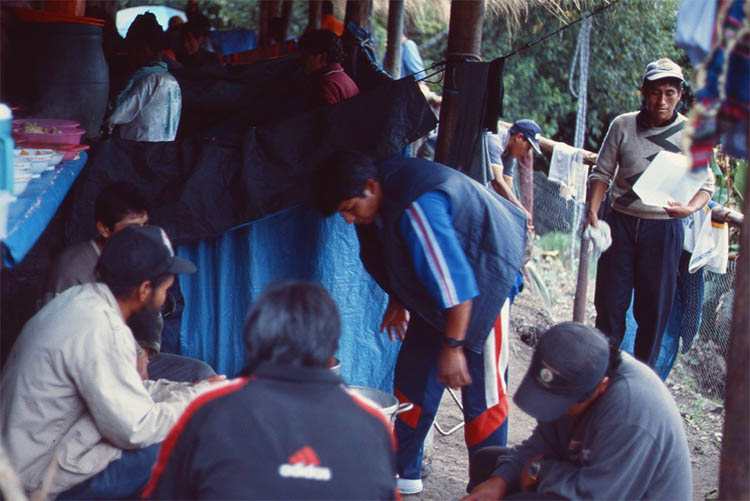
| All the guides are cooking
|
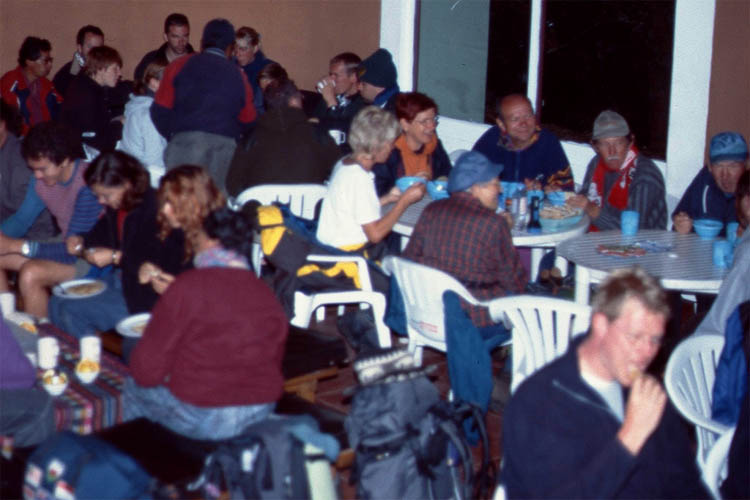
| All the tourists are eating
|
So, it was also easier to get up at 3 o'clock in the morning. That was a must if you do not want to miss the sunrise over Machupicchu. After one and a half hour walk on the Inca trail, we reached the "Gate of the Sun".
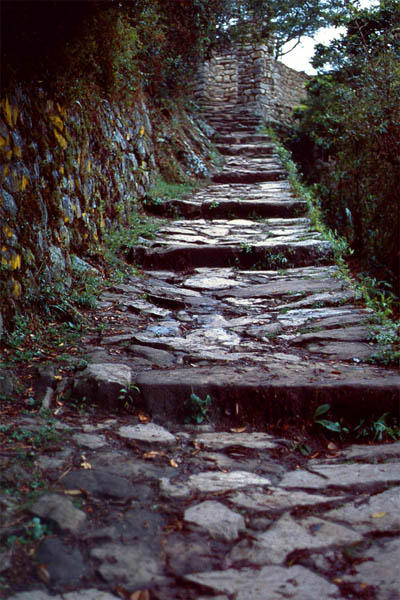
| Going up the Inca Trail
|
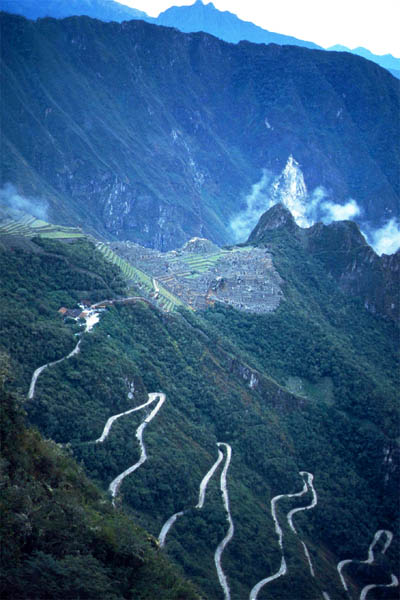
| Looking down to Machupicchu
|
Machupicchu
And then we saw it: Machupicchu in the first appearance of light. Imagine if you would have come here five hundred years ago. It must have even looked much better than now, but without the serpentine road going up (or down). But if you would have come 100 years ago, you would probably have seen neither, because it was fully overgrown by the jungle.
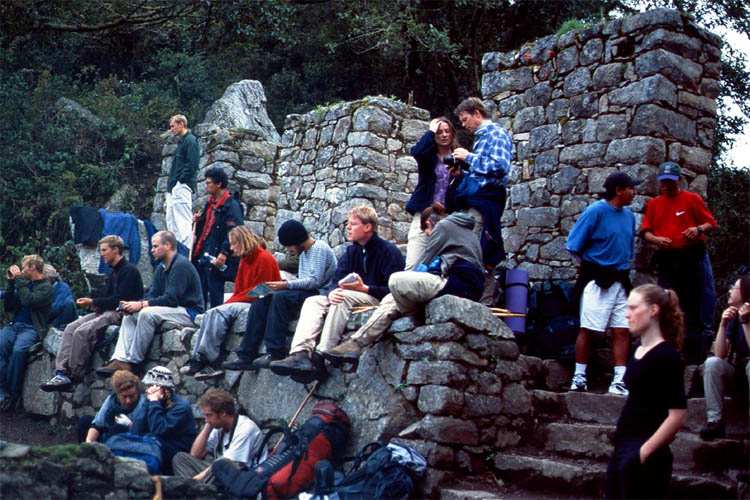
| I am not alone at the Gate of the Sun
|
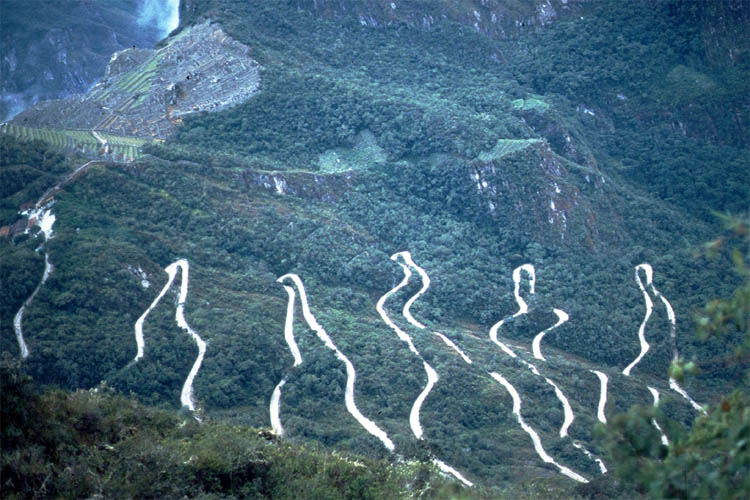
| to watch the sunrise over Machupicchu
|
Finally we saw a first glimpse of the sun. And with the sun came the mist and we saw neither sunrise nor Machupicchu. Also, the whole sky was overcast, thus the photo images are not so colorful. Ok, it does not matter that much, because all the buildings are gray anyway.
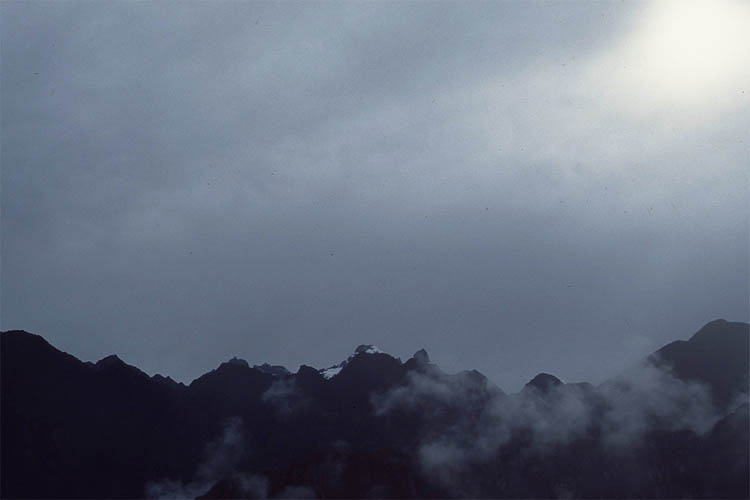
| Unfortunately we saw only a sun through the mist
|
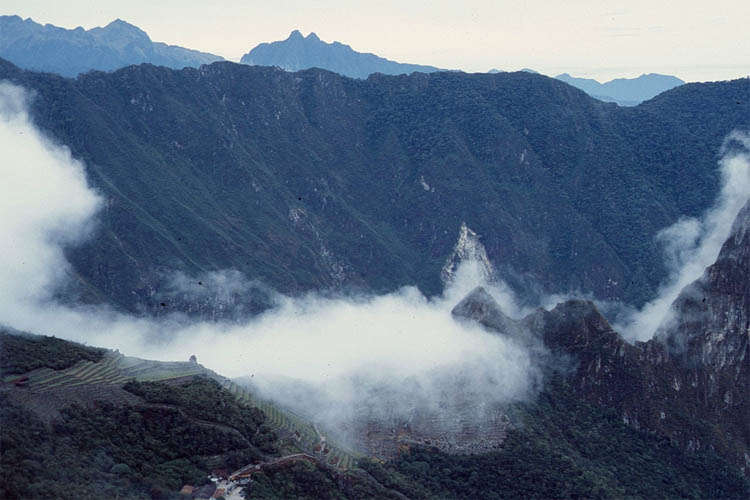
| and all of Macchupicchu is also covered with it
|
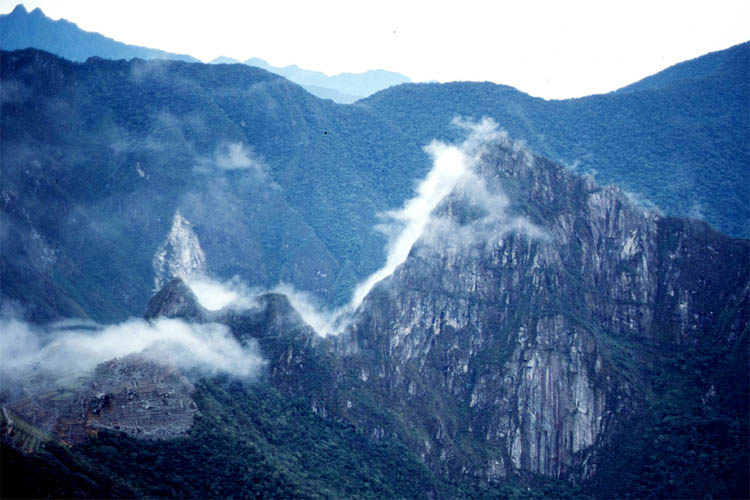
| Still an impressive view from the peaks high up
|
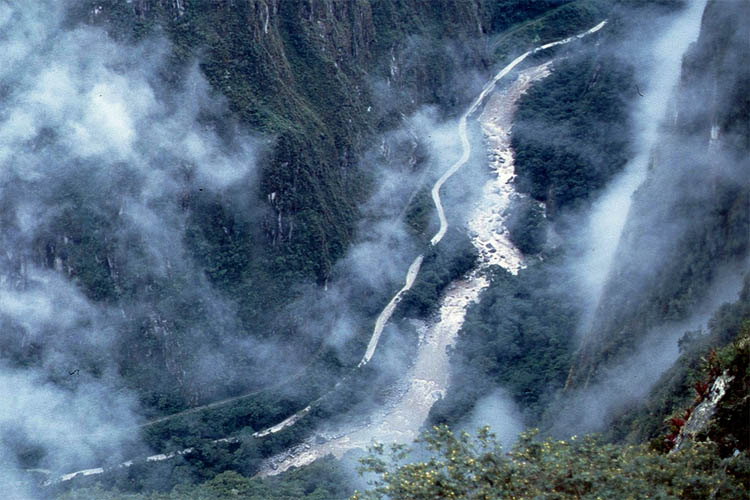
| to the Urubamba valley deep down
|
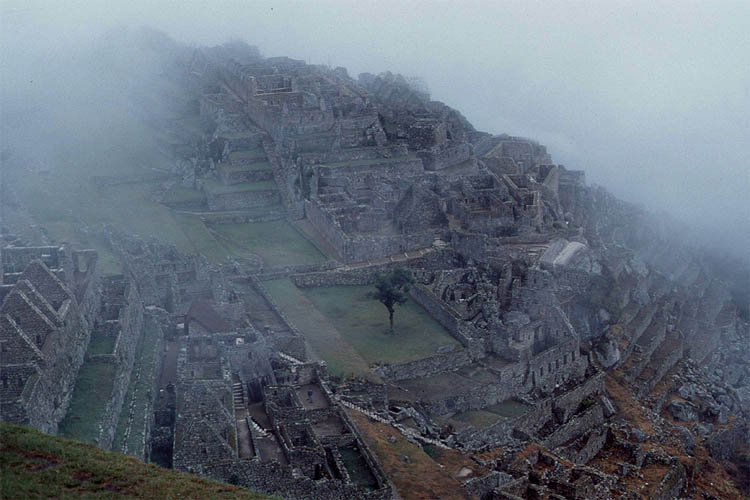
| Slowly the fog disappears too
|
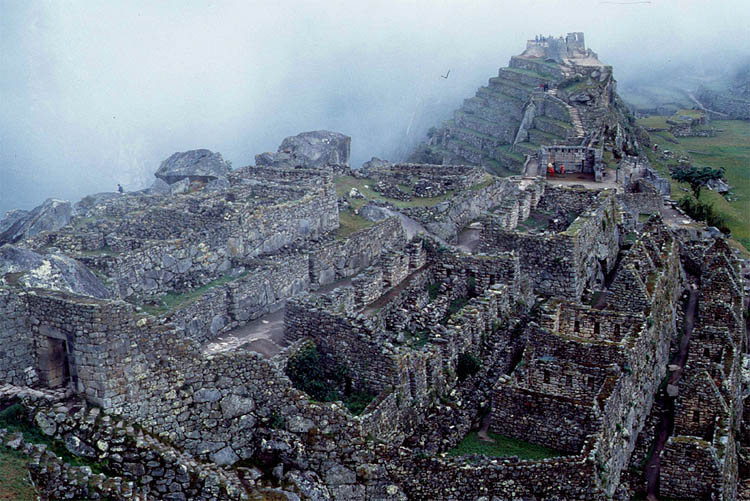
| and soon we get a better view
|
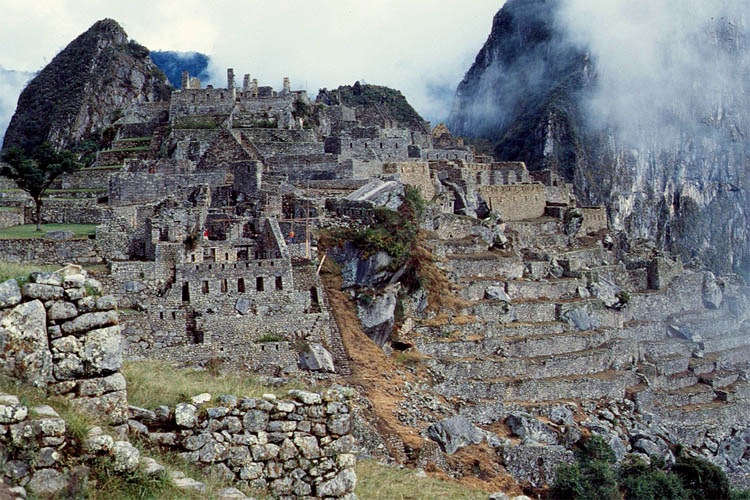
| And it gets more impressive
|
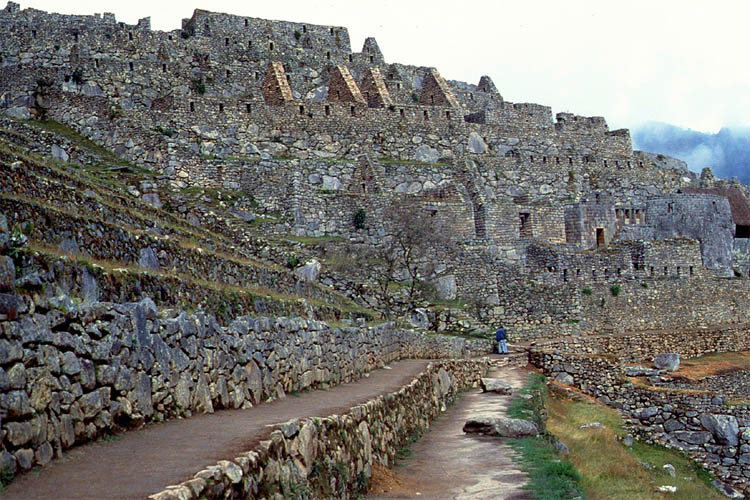
| the closer we get to it
|
First thing to see is the Temple of the Sun, of course, to pray for sunshine. But is it really the sun temple? We do not want to worship the wrong god. But where is the proof?
For real proof we have to wait until June 21, the summer solstice, when a sun ray coming through a trapezoid window and hits exactly an indention on a rock table inside the sun temple. Also, the semicircle shape of the building is the same as the one in Cuzco uncovered from under the church Santo Domingo.
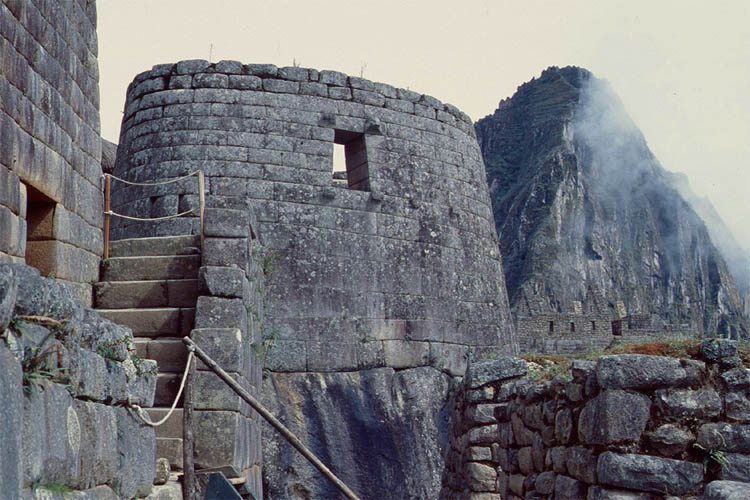
| Finally we reach the Temple of the Sun
|
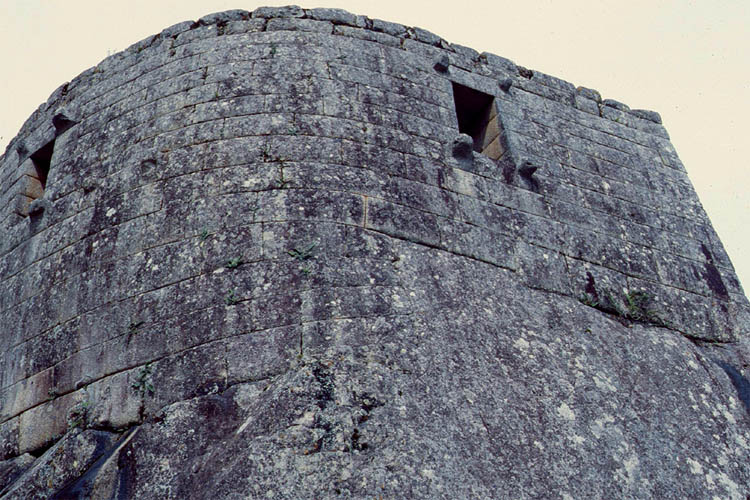
| with the most perfect walls
|
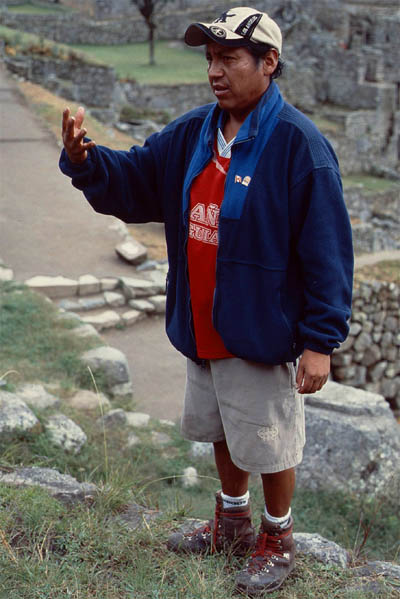
| Our guide explains a lot
|
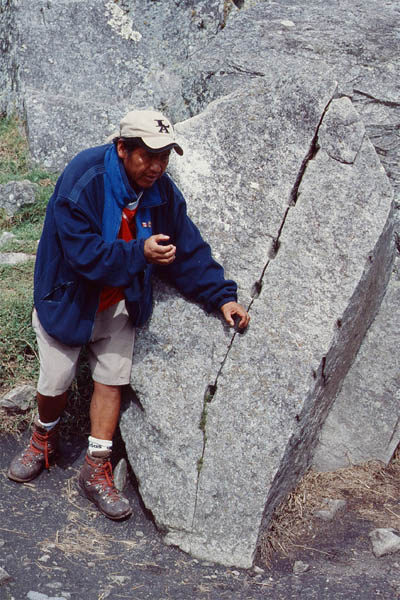
| also how the stones were cut
|
Another question: How were the stones cut? There was one proof of how to break down the big stones as our guide has shown on the photo above.
Small holes are chiseled out along a line on the rock to be cut. Then dried wooden sticks are driven into the holes and water poured over in order to let the wood expand until the stone breaks apart along the line. The same marks I have seen on an unfinished obelisk in Egypt, where a guide gave the same explanation.
Sounds simple? But how much work did it take to cut the stones further with such exact measurements and polish them so smooth. Nobody really knows.
Next comes stairs, but to where? Is it leading up to heaven? A couple of rich ornamented mummies have been found here. The discoverer Mr. Hiram Bingham (more about this guy later on) named the room Mausoleum of the Kings. But nobody knows they were Inca "kings".
Then there is a complicated irrigation system. But for what? There is no soil for growing plants, only some tubs but not deep enough to serve as a bath. Nevertheless, it' s called the Bath of the Inca. But nobody knows the real purpose. But no soil now does not mean that there was none before, maybe to grow veggies. Who knows?
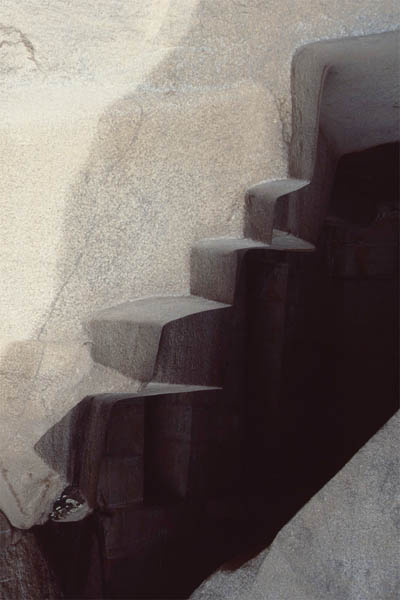
| Explains itself: stairs, but leading to where?
|
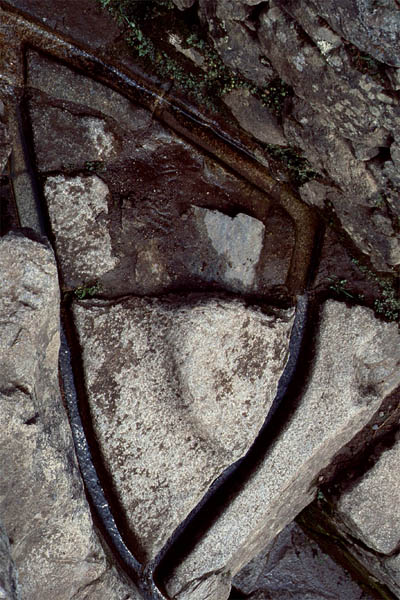
| But what is the use of these small water canals
|
Questions over questions. All the answers are still assumptions, more or less. But if you are an esoteric person and believe in mystics or spirituality you may have found many answers, maybe even more than the Incas believed in.
The following stone seemed to have become a pilgrimage location for all kinds of esoteric people believing in its power to heal by holding the palm of the hands close to the stone but without touching it. Later on the train I even saw a lady who seemed to be fully charged by that stone with healing radiation. She passed it be moving her hands slowly in a distance over the arm of another passenger to subsequently shake out the hands over the floor, so to shake off all evil and bad health.
But the stone was simply part of some kind of a sun dial and planetary and constellation observatory and a compass. I checked it out with my compass: One corner of the stone did show to the north.
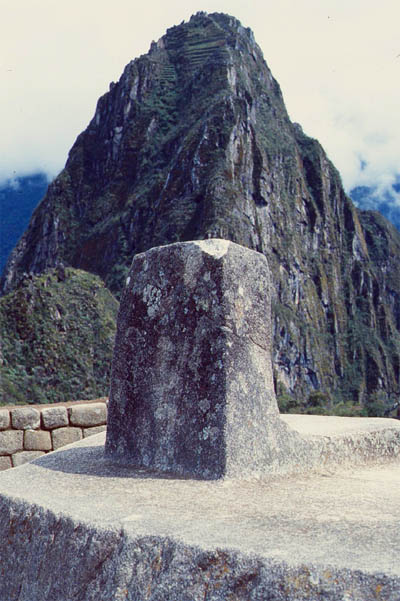
| This is supposed to be a magic stone
|
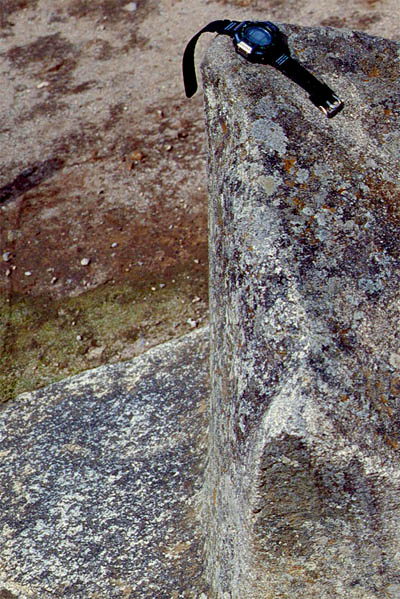
| But it is just part of an observatory
|
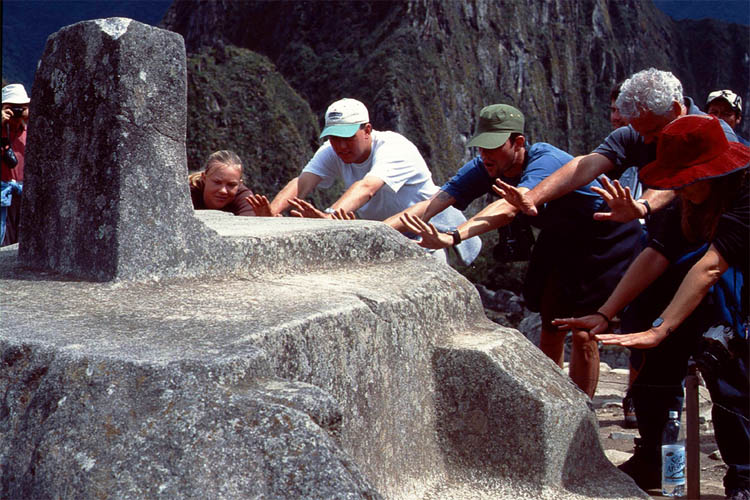
| Do they really believe to get more health energy?
|
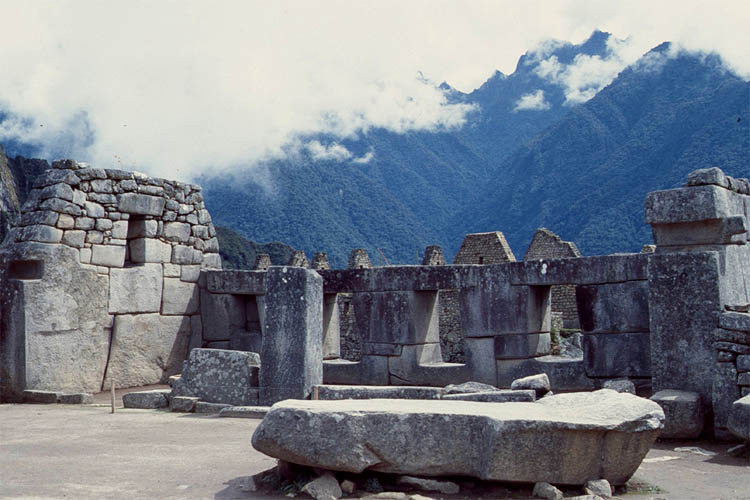
| May it not be better to lie on this stone?
|
Then I continued to walk around alone. So I could leisurely stop at any place I liked to look around with awe and to contemplate. How must it feel to be an Inca and to have lived here? And not just like a peasant but a nobleman, a prince or even an Inca king.
And it may very well be that the royal family was hiding here and also launched some attacks against the Spaniards back in Cuzco. The resistance of the Incas eventually stopped after the execution of the last Inca "king" Tupac Amaru in the year 1572.
Imagine, the Inca dynasty could have survived here for many generations, because this place was never found by the Spaniards. Even if, then it couldn't easily be conquered because it was also a strong and autarkic fortress. Take a look at all the pictures of Machupicchu and you know why.
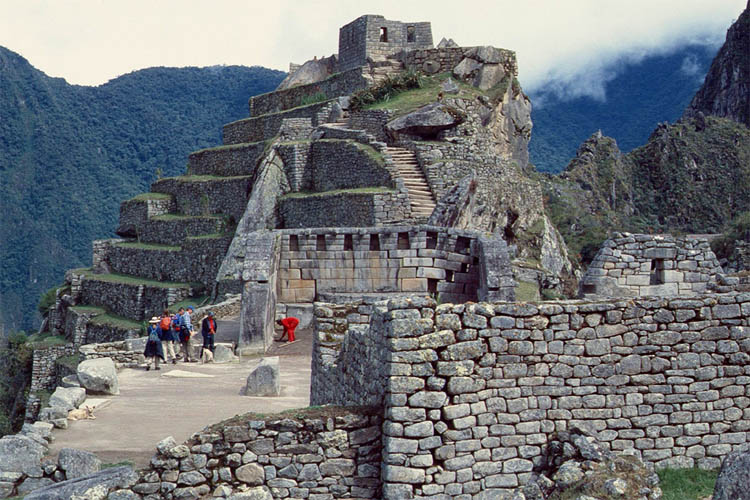
| The temple on the hill looks nice
|
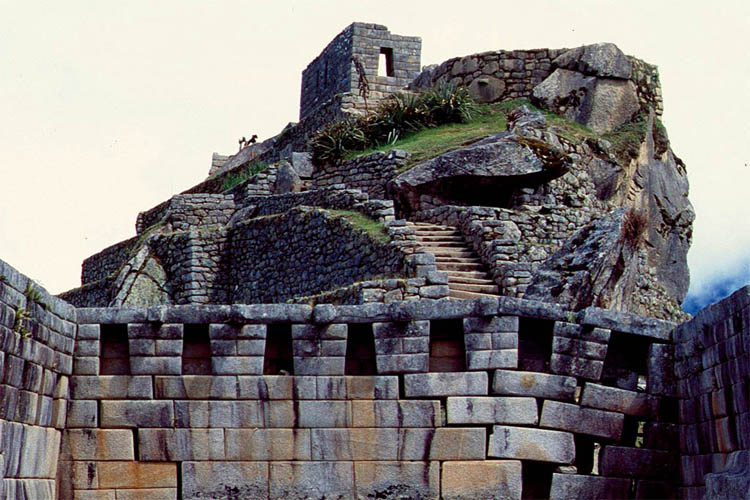
| Let's go up and pray for sunshine
|
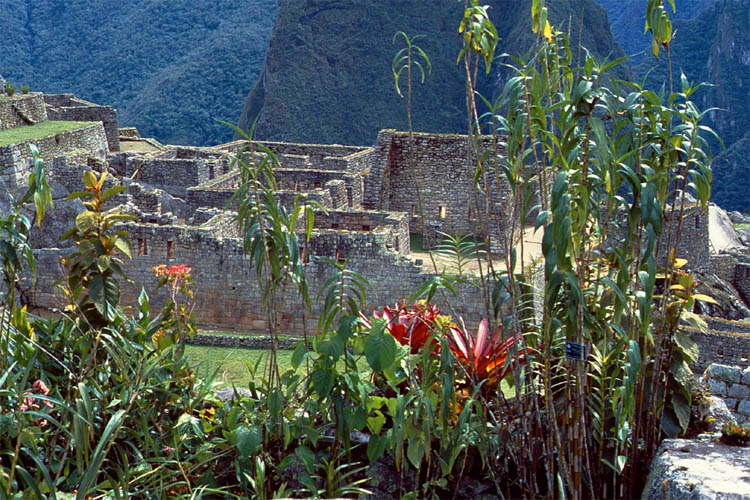
| And there it is: the sun light
|
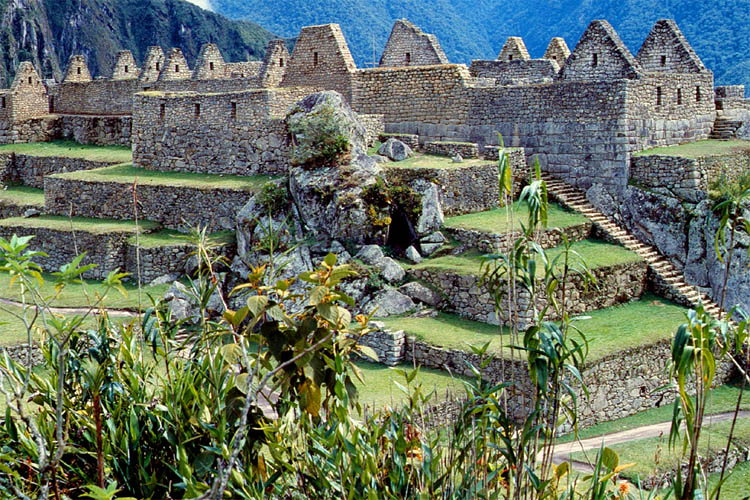
| It's a much better sight
|
I don't want to bore you with too many descriptions and explanations. Much may be wrong now. Better look up a newly updated guidebook. Maybe you will learn that the stone rings are not dog food bowls and the niches are neither bathrooms nor used for dead ancestors (see photo at the bottom), but ....
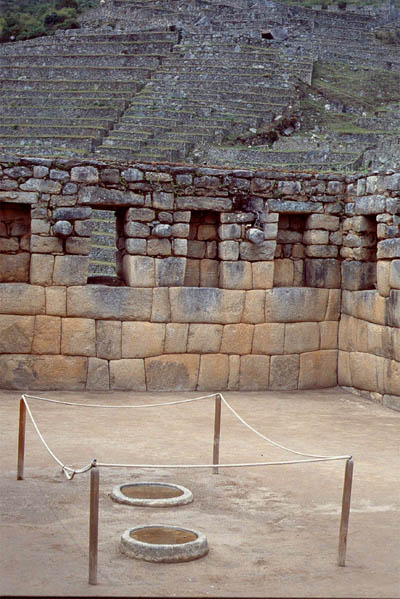
| And what can this be? Dog's food bowls?
|
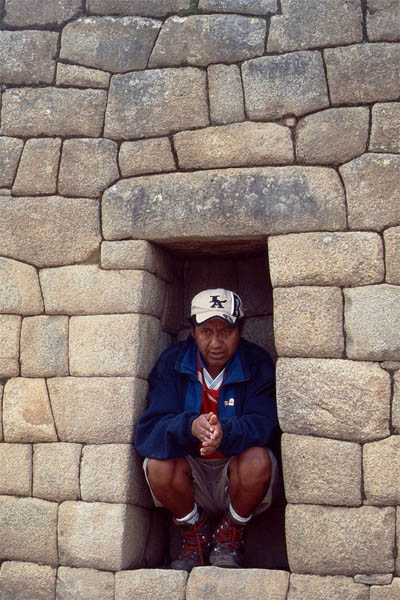
| What is the niche for? Nobody really knows!
|
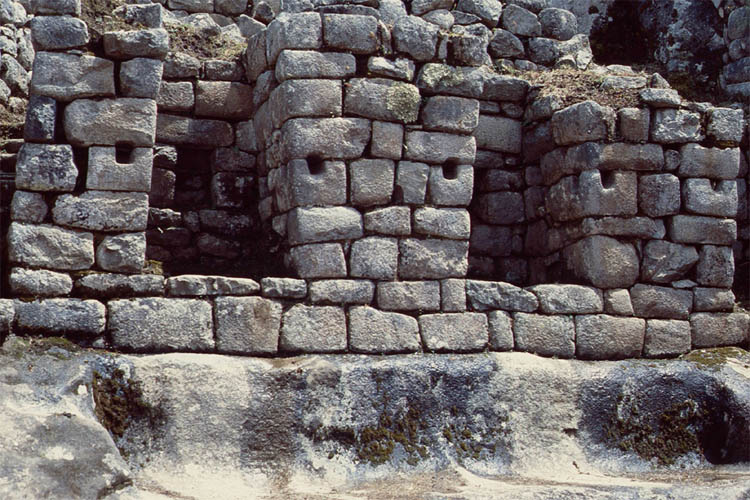
| The niches may be used for decorations
|
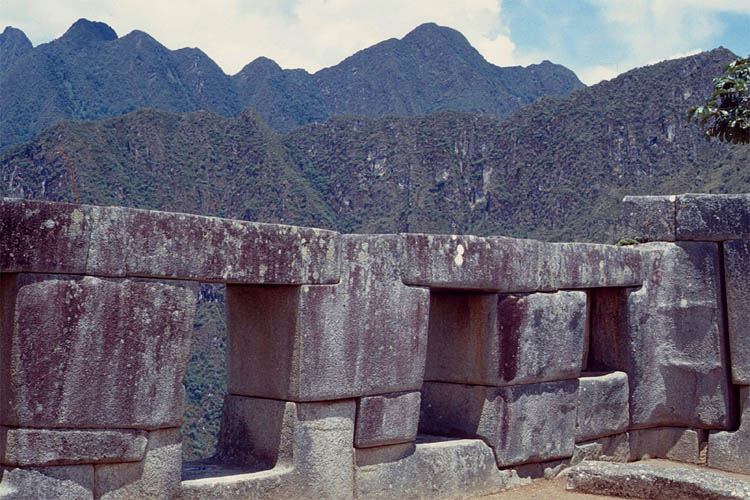
| A similar shape is also used for lookouts
|
Now back to Hiram Bingham. He has been acknowledged as the "scientific" discoverer of Machupicchu in 1911, because others have already found documents about the existence and indigenous people have known it for a long time and some Westerners tried to reach it and some really visited it briefly just a few years before Bingham.
You better look up the many stories about the discovery in various books.
In short: Bingham's expedition was sponsored by the Yale University and the National Geographic Society. He wanted to find Vilcabamba (another story) but stumbled over Machupicchu, deserted and overgrown for 400 years. He cleaned it up, excavated and refurbished the buildings. It became known to the world, after he has published a sensational report in the National Geographic Magazine.
But Peru complained that Bingham called himself the only discoverer, which he wasn't, of course. But if he would not have enhanced Machupicchu archeologically, it would not have become a World Cultural Heritage, and the government of Peru would not profit from the many tourists coming more and more every year and paying 100 US Dollar to see Machupicchu now ( I paid only 12 USD in 2000 as you know).
Enough history for now. Take a look at the following photos with some explanatory text. Everything else would be just assumptions anyway.
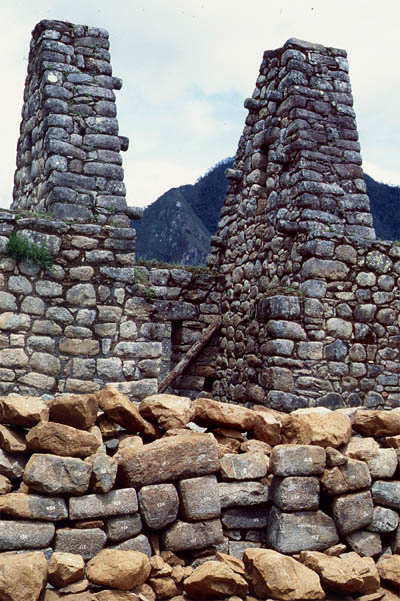
| This is some kind of a tower gate but closed
|
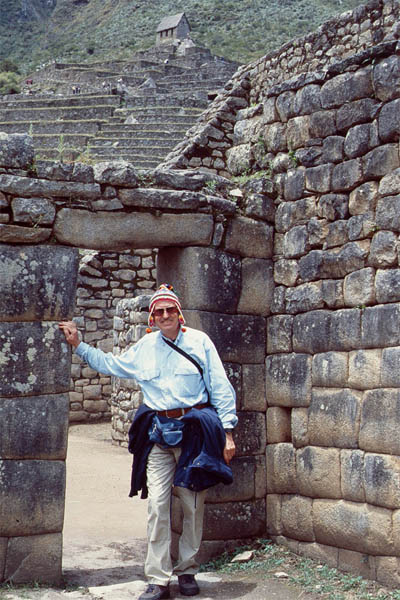
| This is just a door opening without a door
|
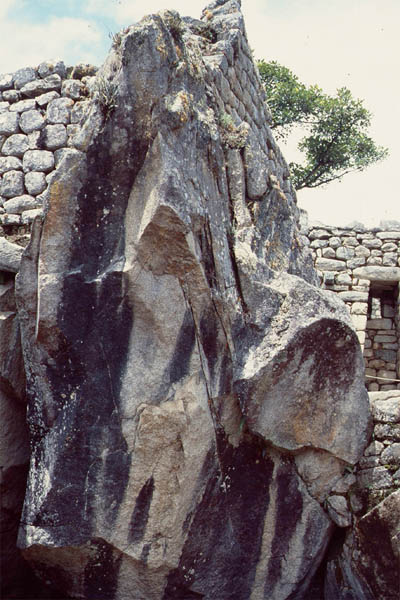
| Some rocks are standing around
|
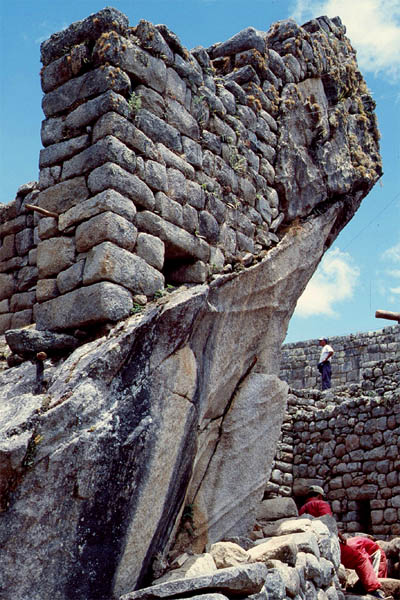
| and some have been integrated
|
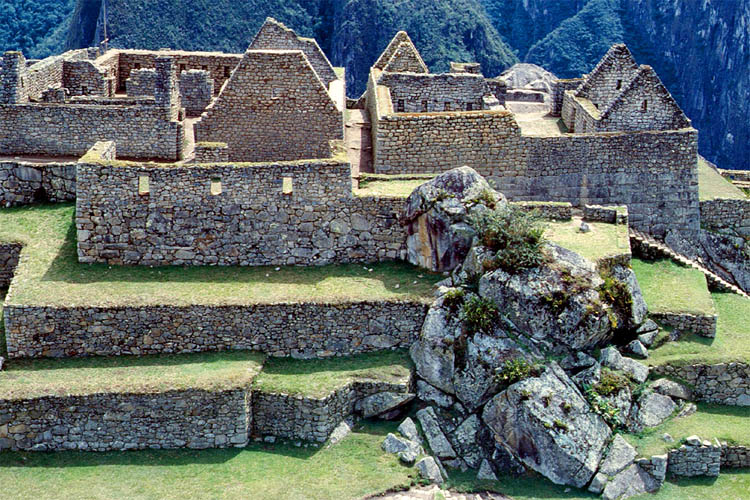
| Some rocks look like part of the countryside
|
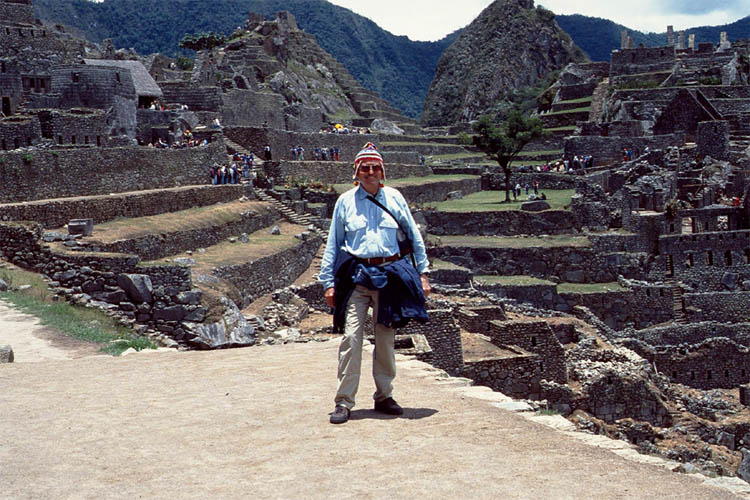
| I am standing like a rock in the middle of the whole site
|
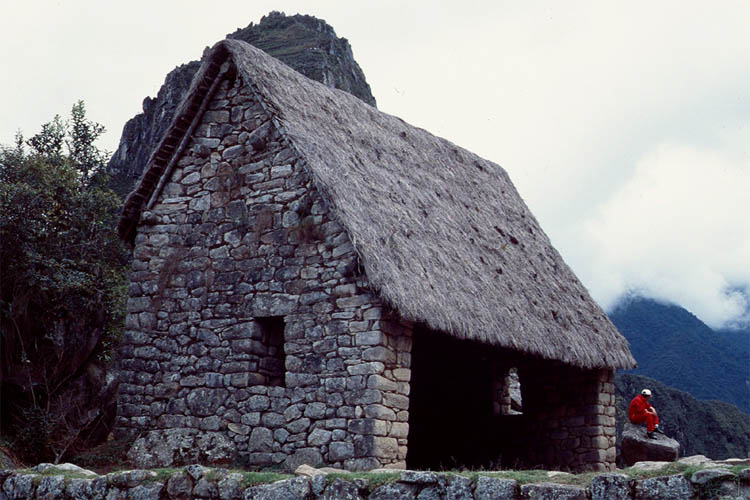
| This house did get a new roof
|
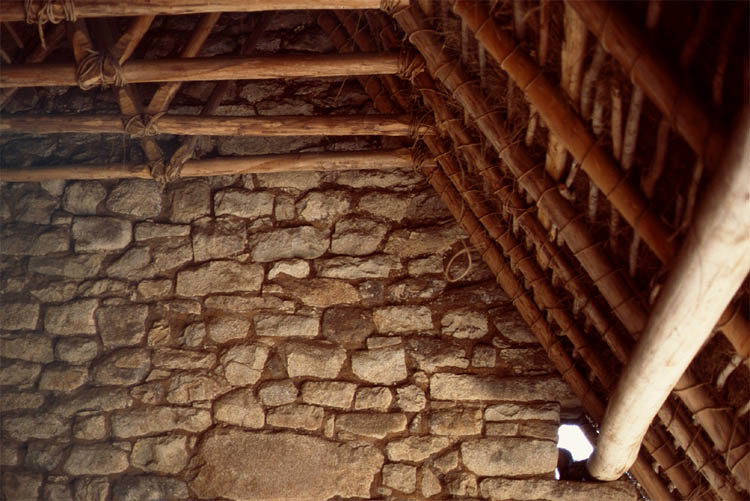
| the way the Incas may have used
|
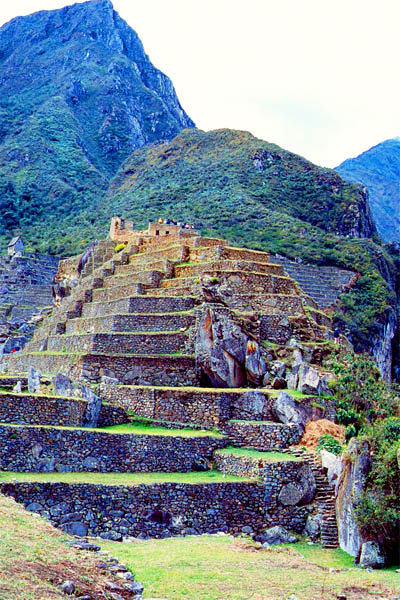
| O lot of walking up
|
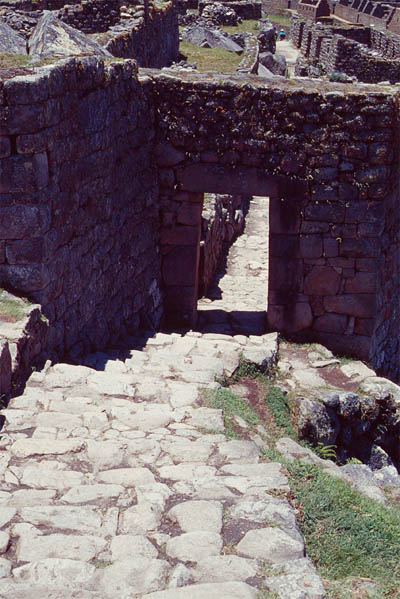
| and looking down
|
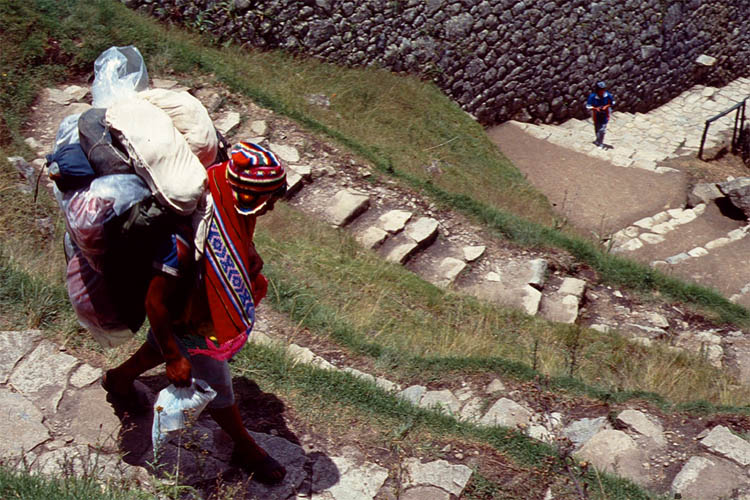
| Then I met a "real" Inca coming down the hill
|
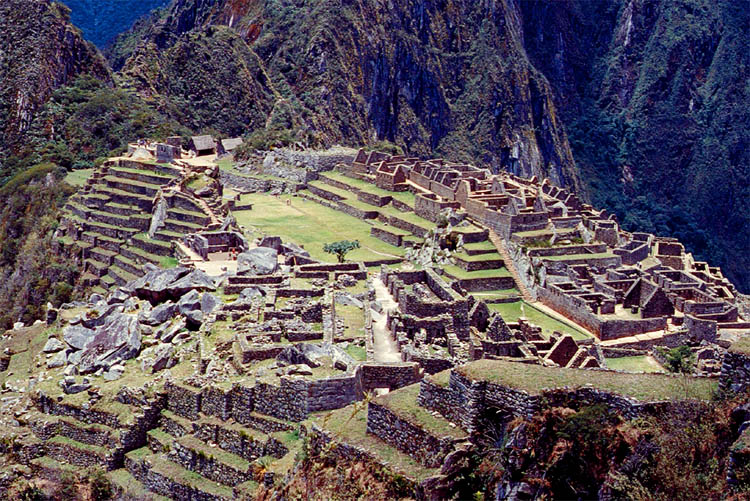
| and I am on my way up to get the last thrill
|
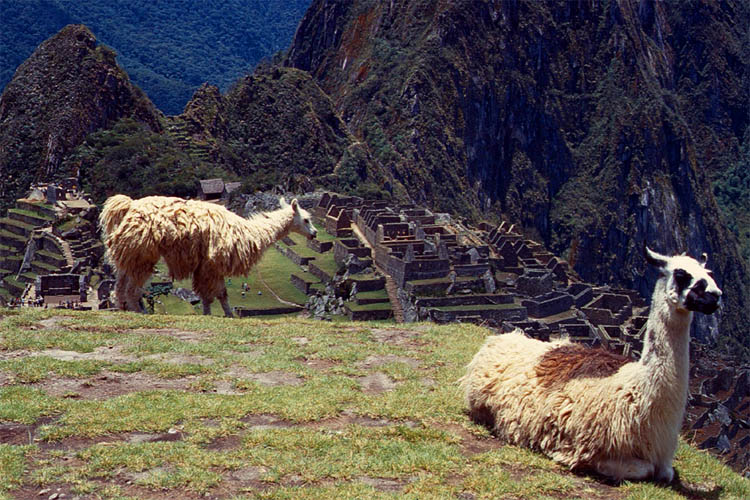
| Then I met real llamas looking down to Machupicchu
|
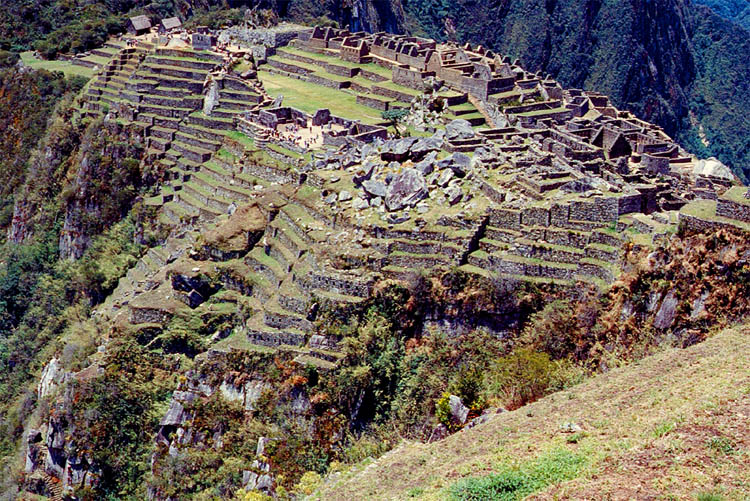
| and this really is the most fantastic view
|
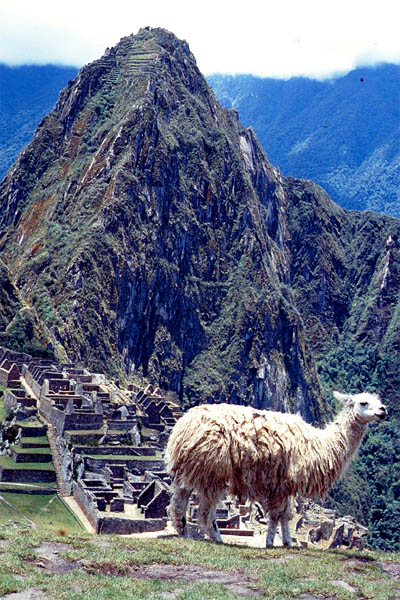
| Hey llama, move to the right
|
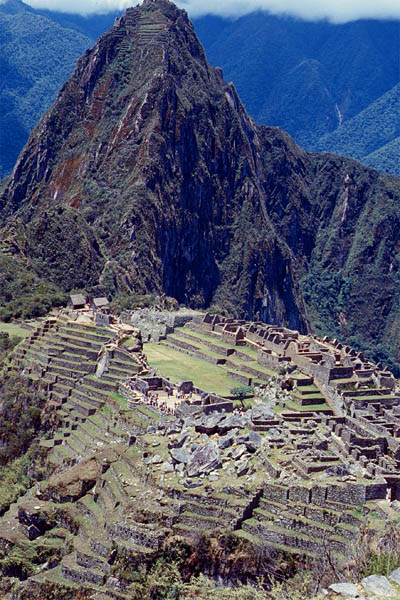
| so I can shoot not you but the most perfect sight
|
Now it was time to leave. Firstly, I had seen enough. Secondly, it did get crowded more and more with people coming up by bus. Thirdly, I wanted to inspect the town of Aguas Calientes below and to get something to eat and to be ready for my train ride back to Cuzco.
Aguas Calientes
My feet were not killing me yet so I walked down all the way to the Urubamba river by using the foot path cutting short the serpentines. There were boys, who ran down the same path faster than the bus could drive on the road. They waved anew at each left curve and the passengers wondered whether they are the same boys or not (like the fairy tale of the hare and the hedgehog). The tourists found out soon and the boys were awarded at the last turn.
Aguas Calientes is a small town and named after the hot springs around. It is a stopover for many tourists who want to get up to Machupicchu without trekking on the Inca trail. It's also a place to relax in a hot spring bath. However in 2010 the wild Urubamba sprang out of its bed and caused a big flood, though not hot. Many tourists did get stuck for many days and also Machupicchu was closed down for a while after.
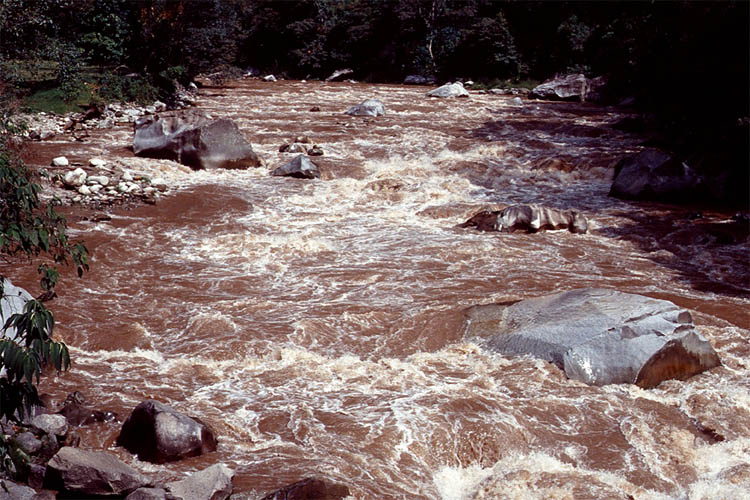
| The wild Urubamba
|
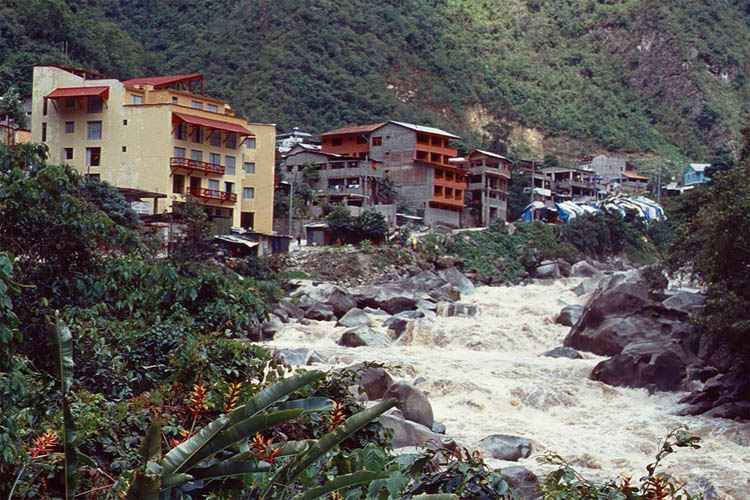
| and the town of Aguas Calientes
|
Back in Cuzco
I didn't stay long in Aguas Calientes. Just had some kind of a late lunch in one of the many restaurants. My guide brought me to the train station to get me the last seat. I was back in Cuzco in the evening.
The train takes some unusual stretch of tracks down a steep hill getting into Cuzco. It's like serpentines but without curves at each end (of course) so the train has to go back and forth while switching to the next lower level track, or vice versa if going up.
I was told not to leave Cuzco without eating a cuy, a guinea pig. But I could have easily left without it. The living cuy must have been cute like a pet but dead it looked very bad with sticking out front teeth. I bared my teeth and asked the waiter to get rid of the cuy's teeth by cutting of its head. Then I was able to eat but it was no delicious meat.
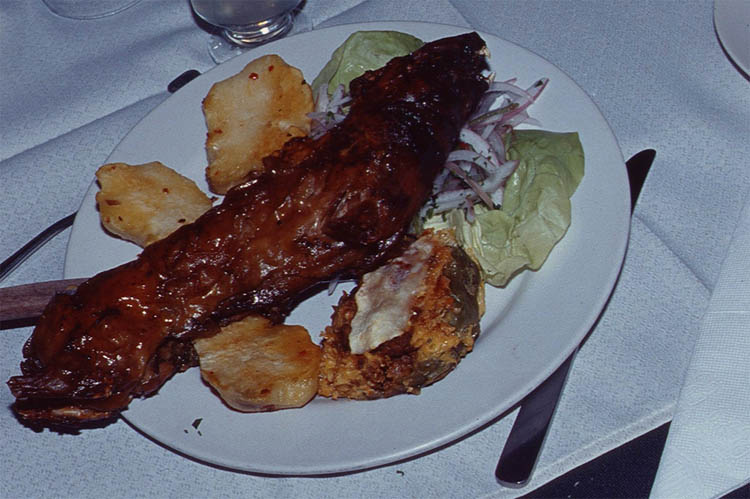
| A guinea pig
|
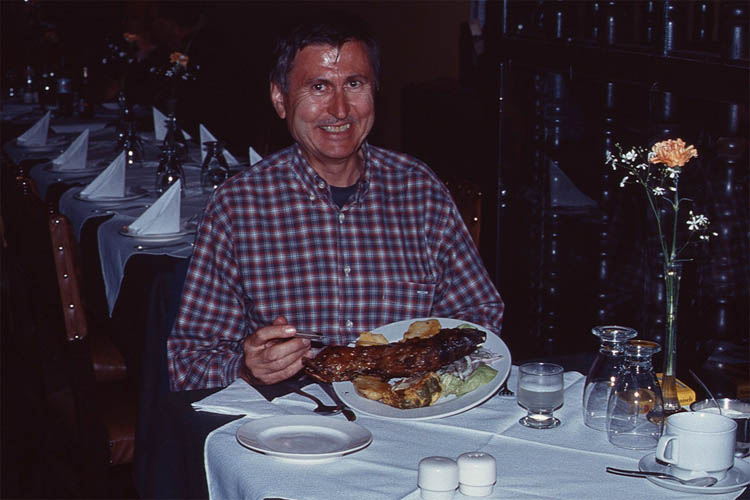
| as my last supper
|
Then a folklore show started with music and dances. So it must be a touristy place. But there were no other guests at all, yet. It looked like that they were expecting a travel group later in the evening. I hoped the restaurant had enough cuys.
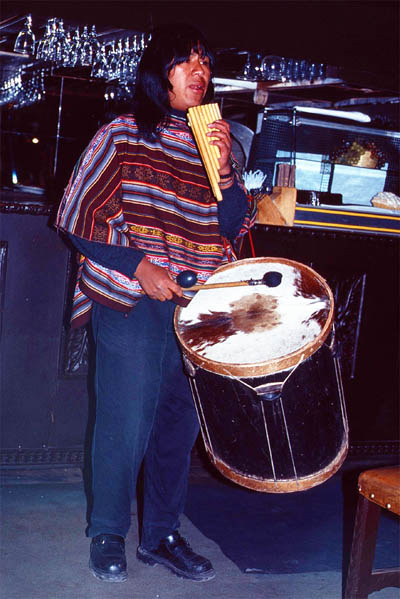
| Little drummer boy
|
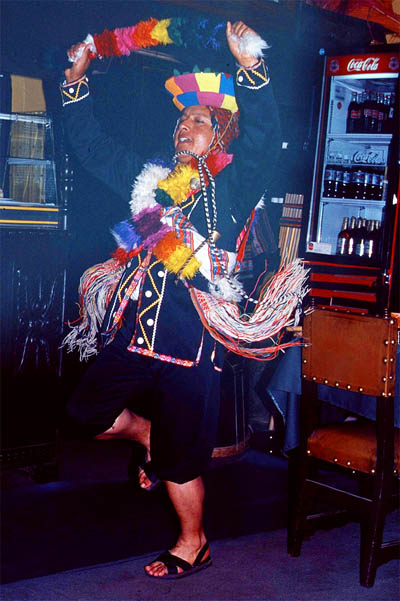
| Little fancy dancer
|
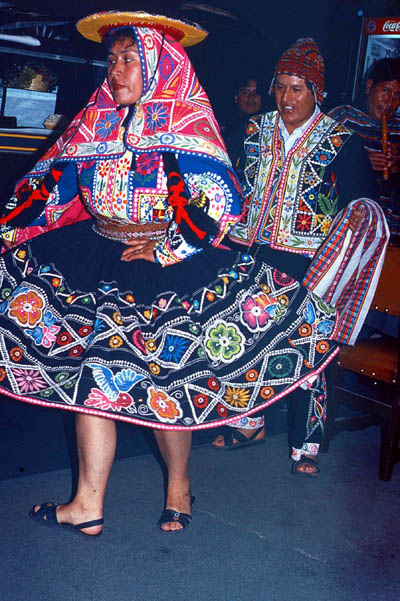
| Lady in a traditional dress
|
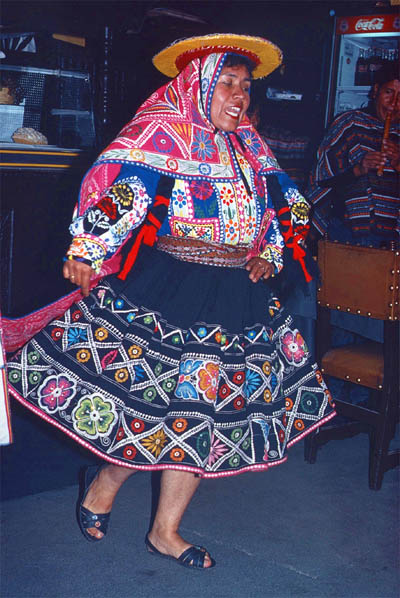
| Dancing round and round
|
Back to Lima
Next morning I was leaving Cuzco. It was a smooth flight with a good sight over the countryside. In Lima I was picked up by Karl's driver who did not miss me this time.
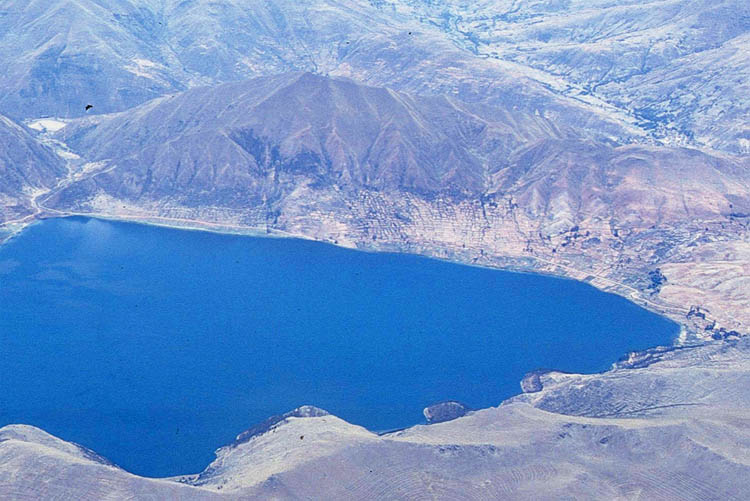
| Flying
|
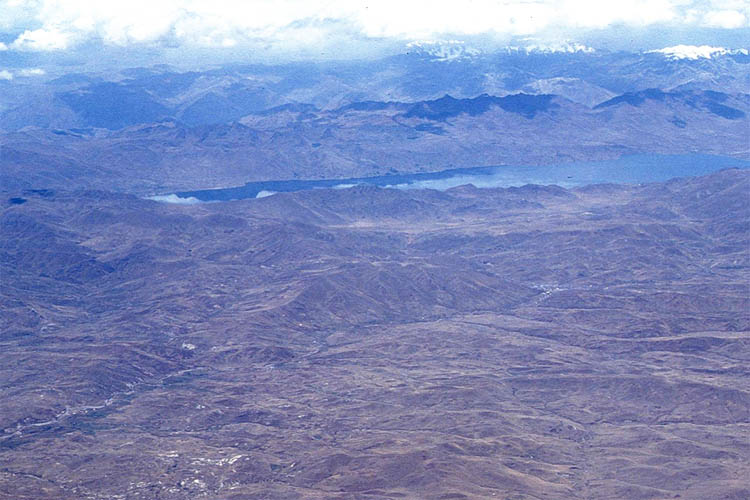
| back to Lima
|
I stayed again at Karl's place. He was so kind to give me a lift to the famous Gold Museum were I was wandering around in awe. All that gold and the many gems, nicely crafted into ceremonial and cultural objects and utensils.
This was only a small part of the riches of the Inkas and of preceding cultures. Imagine, the conquistadores didn't value much the intricate craftsmanship but melted it all to bulllion to be sent to the king of Spain.
It was a pity that I was not allowed to make photos, though I managed to shoot a couple from the hip. No way to steal anything, because the treasures are very well protected. And not only treasures are secured. I saw even chained and locked faucets and plumbing in a restaurant's bathroom in one of the wealthy neighborhood of Lima, in Miraflores.
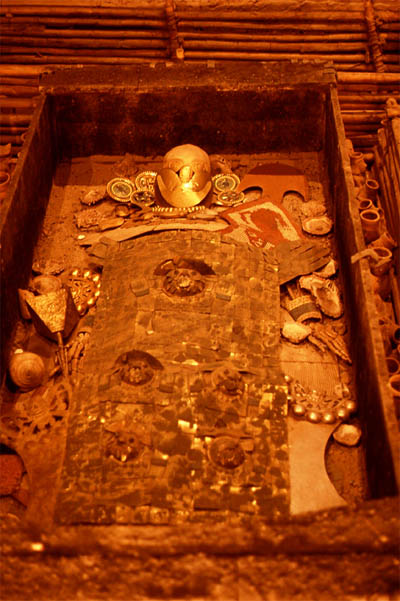
| I would prefer this nice grave
|
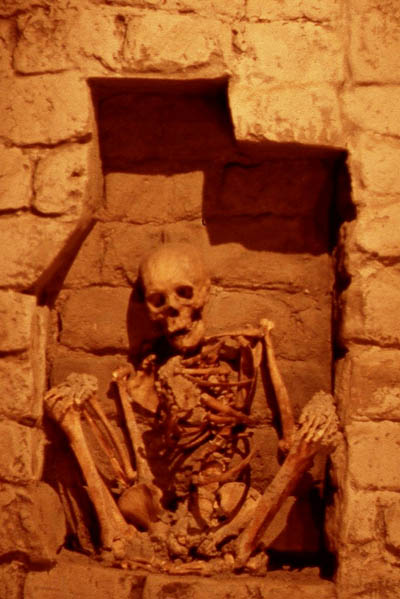
| instead of this cramped place
|
I had a good night's sleep in Karl's house knowing that it is surrounded by a huge wall and watched by a guard all night. Next day I was safely driven by Karl's chauffeur through Lima to the airport without being carjacked. Good Bye, Lima, good bye Peru. No highjacking either during the flight back to good old Europe.
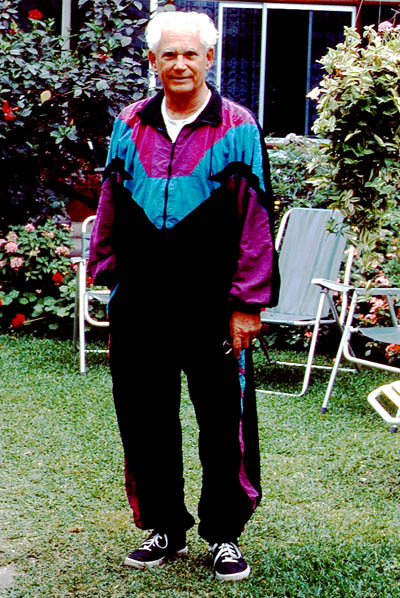
| Good bye, Karl in Lima
|
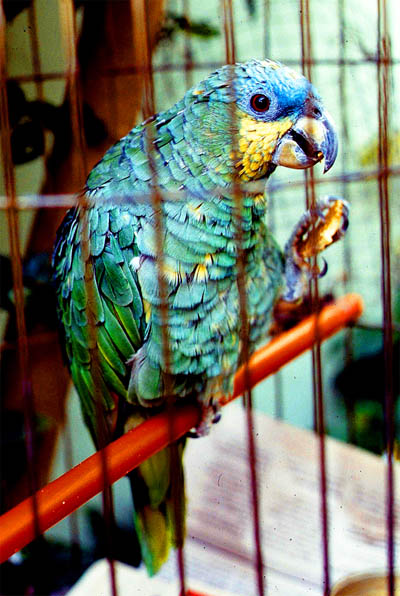
| Good bye, parrot in Peru
|
Ok, that was Peru, though only a very small part of it. I could have seen and done a lot more. Also I could have written more. If you want to know more about all the places I have visited, then just look up any of the many guidebooks or in the internet.
| 










































































